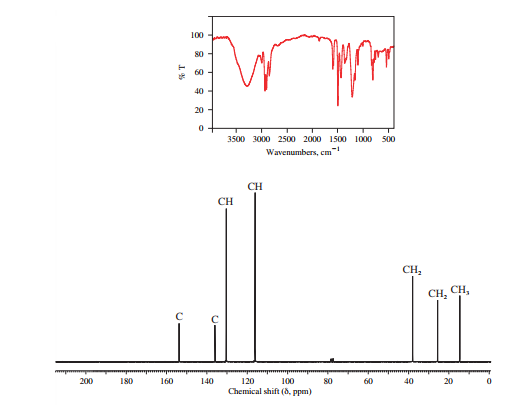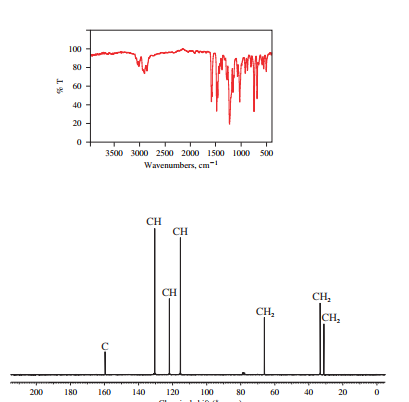
Concept explainers
Interpretation:
Two compounds are to be identified on the basis of their chemical formulas, and IR and
Concept introduction:
Peaks in an IR spectrum help in determining
In 13C NMR spectroscopy, we get information about the different types of carbon present in the given molecular formula.
13C NMR spectroscopy can even differentiate between primary, secondary, tertiary, and quaternary carbons.
If the compound only contains C, H, and O, the index of hydrogen deficiency is calculated as
If a compound contains C, H, O, and a halogen, the halogen can be treated as if it were a hydrogen for the purpose of calculating index of hydrogen deficiency.
Answer to Problem 35P
Solution:
a) The structure of the compound

b) The structure of the compound

Explanation of Solution
The chemical formula of the compound is
The count of four indicates the possibility of a benzene ring. If a benzene ring is present, the oxygen atom would be singly bonded, either as a hydroxyl group or as an ether functional group.
The IR and 13C NMR spectra of the compound are as follows:

The presence of a broad peak around 3200

Chemical formula of the compound is
Therefore this compound also is likely to have a benzene ring.
The IR and 13C NMR spectra of the compound are as follows:

Two peaks in the IR spectrum, at about 700 and 750
Therefore, the structure of the compound is

Want to see more full solutions like this?
Chapter 23 Solutions
ORGANIC CHEMISTRY-PACKAGE >CUSTOM<
- Show the mechanism steps to obtain the lowerenergy intermediate: *see imagearrow_forwardSoap is made by the previous reaction *see image. The main difference between one soap and another soap isthe length (number of carbons) of the carboxylic acid. However, if a soap irritates your skin, they mostlikely used too much lye.Detergents have the same chemical structure as soaps except for the functional group. Detergentshave sulfate (R-SO4H) and phosphate (R-PO4H2) functional groups. Draw the above carboxylic acidcarbon chain but as the two variants of detergents. *see imagearrow_forwardWhat are the reactions or reagents used? *see imagearrow_forward
- The two pKa values of oxalic acid are 1.25 and 3.81. Why are they not the same value? Show the protontransfer as part of your explanation. *see imagearrow_forwardасть Identify all the bonds that gauche interact with C-OMe in the most stable conformation of the above compound.arrow_forwardPredict the reactants used in the formation of the following compounds using Acid-Catalyzed dehydration reactionarrow_forward
- Can I please get help with this?arrow_forward.. Give the major organic product(s) for each of the following reactions or sequences of reactions. Show ll relevant stereochemistry [3 ONLY]. A H Br 1. NaCN 2 NaOH, H₂O, heat 3. H3O+ B. CH₂COOH 19000 1. LiAlH4 THF, heat 2 H₂O* C. CH Br 1. NaCN, acetone 2 H3O+, heat D. Br 1. Mg. ether 3. H₂O+ 2 CO₂ E. CN 1. (CH) CHMgBr, ether 2 H₂O+arrow_forwardAssign this COSY spectrumarrow_forward
 Organic ChemistryChemistryISBN:9781305580350Author:William H. Brown, Brent L. Iverson, Eric Anslyn, Christopher S. FootePublisher:Cengage Learning
Organic ChemistryChemistryISBN:9781305580350Author:William H. Brown, Brent L. Iverson, Eric Anslyn, Christopher S. FootePublisher:Cengage Learning

